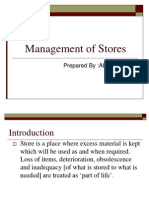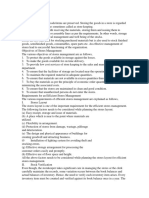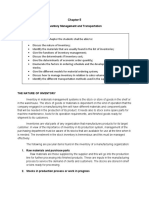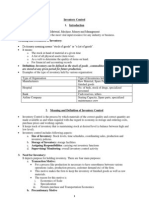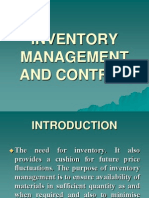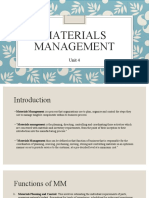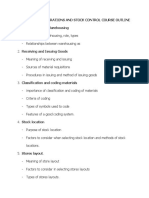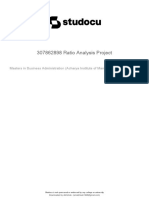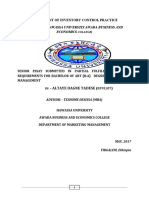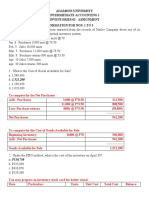Unit 4 - PMM
Unit 4 - PMM
Uploaded by
Ash RoyCopyright:
Available Formats
Unit 4 - PMM
Unit 4 - PMM
Uploaded by
Ash RoyOriginal Title
Copyright
Available Formats
Share this document
Did you find this document useful?
Is this content inappropriate?
Copyright:
Available Formats
Unit 4 - PMM
Unit 4 - PMM
Uploaded by
Ash RoyCopyright:
Available Formats
Unit 4
Stores Management
By: Ms. Rashika
Assistant Professor
Meaning
As all the activities in any organization cannot be carried out at one
point of time, storage is an inevitable process
The cost of capital blocked in inventories is substantial. If this part of
working capital is not properly managed the subsequent losses may be
enormous. The success of the business, besides other factors, depends
to a large extent on the efficient storage and material control
Stores management is concerned with carrying the right kind of
materials in right quantity, neither in excess nor in short supply,
providing it quickly as and when required, keeping it safe against any
kind of deterioration, pilferage or theft, and to carry out the efficient
performance of all these functions at lowest possible cost.
Objectives
To facilitate a balanced and smooth flow of raw materials,
components, tools and equipments required to meet
production requirements
To maintain optimum stock of materials
To achieve efficient utilization of storage space
To reduce usage of materials handling equipment
To provide codification of stored items for easy recognition
To enable flexibility in production schedules
To facilitate quantity purchases at discounted prices
To prevent damage, wastage and deterioration of stored
materials
To maintain the record of all incoming materials and issue of
material to user department
Functions
The major functions of the stores are as follows:
a) Receipt: Receiving and accounting of raw-materials, bought out parts,
spares, tools, equipment and other items.
b) Storage: Provision of right and adequate storage and preservations to
ensure that the stocks do not suffer from damage, pilferage or deterioration.
c) Retrieval: Facilitating easy location and retrieval of materials keeping
optimum space utilization.
d) Issue: Fulfilling the demand of consumer departments by proper issue of
items on the receipt of authorized purchase requisitions.
e) Records: To maintain proper records and update receipt and issue of
materials.
f) Housekeeping: Keeping the stores clean and in good order so that the
handling, preservation, stocking, receipt and issue can be done satisfactorily.
g) Control: Keeping a vigil on the discrepancies, abnormal consumptions,
accumulation of stocks etc., and enforcing control measures.
h) Surplus Management: Minimization of scrap, surplus and obsolescence
through proper inventory control, and effective disposal of surplus and obsolete
items.
i) Verification & valuation: Verifying the bin card balances with the physical
quantities in the bins and initiating the purchasing cycle at appropriate time so as
to avoid the out of stock situations.
j) Coordination and cooperation: To coordinate and cooperate with the
interfacing departments such as purchasing, manufacturing, production planning
and control, inspection, etc.
Methods of stock valuation
FIFO (first-in-first-out)
LIFO (last-in-first-out)
Average price
Weighted average method
Actual price
Current market value/ market value
Standard price/cost method
Stock verification
Some discrepancy is bound to occur between the actual and book
balances of inventory
(i) periodic or fixed annual inventory- A periodic inventory system
only updates the ending inventory balance in the general ledger when
a physical inventory count is conducted. Since physical inventory
counts are time-consuming, few companies do them more than once a
quarter or year
(ii) perpetual or continuous inventory - a reliable way to keep track
of inventory in real-time. A perpetual inventory system is an
inventory management method that records when stock is sold or
received in real-time through the use of an inventory management
system that automates the process. A perpetual inventory system will
record changes in inventory at the time of the transaction. works by
updating inventory counts continuously as goods are bought and sold
Factors to be considered in Stores location
Cost
Nature of material
Value of material
Near to the production unit
Natural resources
Profitability
Easy availability of labor
Factors to be considered in Stores layout
Nature/type of material
Volume/Quantity of material
Availability of space
Scope for future expansion
Physical factors (lighting, safety, ventilation etc.)
Centralized or decentralized stores
Provisions for easy receipt, storage and
disbursement of materials
Accessibility
Classification and codification
Classification is the systematic division,
grouping, or categorization of materials or
items based on some common characteristic.
Classification of materials can be performed
on different bases (e.g., nature, manufacturing
process, value, and purpose). To identify
materials that are purchased and stored for
commercial purposes, they should be properly
classified.
A broad classification of materials is shown below, based on their nature,
use, and service.
•Raw Materials
•Purchased components
•WIP
•Finished goods
•Consumable Stores
•Machinery and Plant
•Factory and Office Equipment
•Inflammable Stores
•Chemicals
•Furniture and Fixtures
•Scrap Materials
•Packaging Materials
•General Stores
Basis
Basis of Manufacturing Process
Based on the manufacturing process, stores are divided into:
Pre-process Stock: These are items that are yet to be used in the manufacturing process and are obtained prior to the start
of production. They include raw materials, bought-out parts and assemblies, and stock in the pipeline of materials in transit.
Intermediate Stock: Intermediate stock comprises the parts or assemblies that are manufactured within the factory for use
in the final product.
Finished Goods or Finished Products: As the name indicates, finished goods are the items that have been duly
manufactured in the factory and are ready for shipment or sale to the customers.
Basis of Value
Based on value, stores may be divided into:
Category A: Category A consists of materials which constitute 5% to 10% of the total items in the stores and represents
70% to 85% of the total stores value.
Category B: This category consists of materials which constitute 10% to 20% of the total items in the stores and represents
10% to 20% of the total stores value.
Category C: This category consists of cheap materials which constitute 70% to 85% of the total items in the stores and
represents 5% to 10% of the total stores value.
Basis of use/ requirement (VED)
Vital
Essential
Desirable
Advantages of classification
1. Helpful in Grouping of Stores Items: Classification helps to group different items in the store.
Items that fall under a particular category can be stored in one location, ensuring optimal use of storage
space.
2. Easy Location: Proper classification of stores items helps in the easy identification of the various
items. Storekeepers can easily find materials whenever they are required in the production departments.
3. Proper Accounting: Record-keeping processes are easier when items are properly classified.
Furthermore, simplified record-keeping ensures accuracy in posting receipts and issues in the stores
records.
4. Proper Care: By classifying items based on value, storekeepers can ascertain their relative
importance. Accordingly, a suitable degree of supervision and control can be exercised that is
proportional to the value of each item.
5. Avoidance of Duplication: Proper classification helps to avoid the possibility of duplicate stock
items and materials.
6. Standardization: Classification helps to standardize various items in the stores. Standardization
involves variety reduction using fixed sizes and types, leading to uniform standards for similar items.
Codification
After classifying and grouping the various
items in an organization’s stores, it is useful to
codify them.
Codification is the process of assigning a
number or symbol to each store item, along
with a name, in order to make it easy and
convenient to identify.
Advantages
Avoidance of long and unwieldy descriptions
Accurate and logical identification of items
Avoidance of duplication
Standardization of purchasing and storage
Reduction of variety
Efficient recording and accounting
Systems of codification
i. Alphabetical
ii. Numerical
iii. Decimal
iv. Combined
v. Brisch system
vi. Kodak system
vii. Color codification
Inventory control of spare parts
Need
random and unpredictable failure of machines and
equipments
Long lead time
High tendency for obsolescence
Not economical to manufacture when the requirement
is small
Stock out cost
Classification of sparts
Based on usage rate
Regularly used
Irregularly used
Based on Movement analysis
Fast moving
Slow moving
Non-moving
Based on functional characteristics
Capital spares
Repairable
Maintenance
Problems of inventory control of spares parts
Location of want
Import policy
Nature of plant & machinery
Availability and lead time for procurement
Uncertain failures
Reliability of the spare parts
Policies for optimizing spare parts inventory
Identify whether to stock certain spare parts or not
Choose a Method for Labeling Critical Components
Keep Your Bill of Materials up to Date - in order to prevent inventory inaccuracies and
spare parts shortages and to better plan for preventative maintenance or servicing. Take
time to review your BOM on a regular or semi-regular basis to add or remove parts from it
as needed.
Calculate Optimal Economic Order Quantity
Focus on Inventory Control During Employee Training
Invest in a Quality CMMS - A computerized maintenance management system (CMMS)
can make it easier to implement some of the spare parts inventory management best
practices listed above, as well as to analyze spare parts, to optimize reorder points, and
more.
Warehousing management
Warehouses are the godowns which take the responsibility of
keeping and storing the goods and providing ancillary services.
Functions/ services offered
Factors affecting location of a warehouse
Cost
Workforce availability
Storage space requirement
Nature of goods
Volume of goods to be stored
Access to Roads, Highways, Airport, Railway Stations &
Ports
Markets & Local Environment Factors
Proximity to Carrier Services: Consider your warehouse’s proximity to
carriers. If your warehouse is located near carrier facilities, it will streamline the process of
shipping your product(s) to your customer. The key is to find a good balance of a location that
offers both convenience and close proximity to your target customers, as well as a carrier service.
Factors to be considered in warehouse layout
Timely customer service.
Nature of goods
Volume of goods
Storage need
Space & shape
Purpose of warehousing
Scope for expansion
Physical factors (lighting, safety, ventilation etc.)
You might also like
- Wiley CFA Society Mock Exam 2020 Level I Afternoon SolutionsDocument47 pagesWiley CFA Society Mock Exam 2020 Level I Afternoon SolutionsLucas Coelho100% (1)
- Final Internship Report 4Document40 pagesFinal Internship Report 4KUMARAGURU PONRAJ100% (1)
- Study of Inventory Management in Manufacturing Industry: Aashna Sharma, Vivek AryaDocument10 pagesStudy of Inventory Management in Manufacturing Industry: Aashna Sharma, Vivek AryaAarthy ChandranNo ratings yet
- Material CostingDocument13 pagesMaterial CostingiqmobiletutorNo ratings yet
- Unit II - Material ManagementDocument13 pagesUnit II - Material Managementsharayu kadamNo ratings yet
- BASIC STORE ADMINISTRATION NOTESDocument25 pagesBASIC STORE ADMINISTRATION NOTESDENIS MCHAUNo ratings yet
- MaterialsDocument30 pagesMaterialsAnonymous 3yqNzCxtTzNo ratings yet
- Management of Stores: Prepared By:Abhinav SinghDocument36 pagesManagement of Stores: Prepared By:Abhinav SinghfikrhomeNo ratings yet
- Chapter 4 Inventory MGTDocument26 pagesChapter 4 Inventory MGTRamadan DestaNo ratings yet
- Cost Accounting - Bcom - Module 2Document8 pagesCost Accounting - Bcom - Module 2vishnubhaskar222No ratings yet
- Storemanagement Unit 5Document82 pagesStoremanagement Unit 5Shifali MandhaniaNo ratings yet
- Inventory ControlDocument23 pagesInventory ControlKomal RatraNo ratings yet
- Mpe 412-Class NotesDocument50 pagesMpe 412-Class NotesKing EdwinNo ratings yet
- Stores ManagementDocument2 pagesStores ManagementRockyNo ratings yet
- Topic 1 Introduction To WarehousingDocument12 pagesTopic 1 Introduction To WarehousingmainaNo ratings yet
- MODULE 3-MATERIAL MANAGEMENT VanmDocument82 pagesMODULE 3-MATERIAL MANAGEMENT VanmBasil StalinNo ratings yet
- Stores 1Document12 pagesStores 1James BoruNo ratings yet
- Inventory NewDocument23 pagesInventory NewSujay SankarNo ratings yet
- A Study On Inventory ManagementDocument22 pagesA Study On Inventory ManagementMehul Panchal100% (1)
- Cost Accounting Module II (2)Document15 pagesCost Accounting Module II (2)apriluhcalNo ratings yet
- CBME1 - Inventory ManagementDocument5 pagesCBME1 - Inventory ManagementPrincess Honeylet SigesmundoNo ratings yet
- Notes For Wed8th ClassDocument5 pagesNotes For Wed8th ClassPeter SsenyondoNo ratings yet
- 5 POM Inventory ManagementDocument52 pages5 POM Inventory Managementbt20107059 Tarun KaushikNo ratings yet
- Unit 3 InventoryDocument42 pagesUnit 3 Inventoryyash.salunkhe20No ratings yet
- Topic 4Document37 pagesTopic 4Tafadzwa MangenaNo ratings yet
- COM RDS 4 SEM HONS CC VIII Unit 2 MaterialDocument18 pagesCOM RDS 4 SEM HONS CC VIII Unit 2 MaterialAnwesha KarmakarNo ratings yet
- Module 5Document11 pagesModule 5Johanna Rullan100% (1)
- Inventory Control: Are Stored at Any Given Period For Future ProductionDocument8 pagesInventory Control: Are Stored at Any Given Period For Future ProductionHema KashyapNo ratings yet
- Material and Labour Cost PPT - Dr.J.MexonDocument50 pagesMaterial and Labour Cost PPT - Dr.J.MexonDr.J. MexonNo ratings yet
- sawa MDocument29 pagessawa Madrianvalentino900No ratings yet
- Mining Materials ManagementDocument20 pagesMining Materials ManagementUDHAYAKUMAR ANo ratings yet
- Inventory Management SystemDocument17 pagesInventory Management SystemPrathap100% (1)
- Accounting For MaterialsDocument31 pagesAccounting For Materialsmuriithialex2030No ratings yet
- Inventory ManagementDocument70 pagesInventory Managementnikhilvaghela2127No ratings yet
- Inventory Management and ControlDocument52 pagesInventory Management and ControlAshish MalhanNo ratings yet
- Chapter 1-MaterialsDocument6 pagesChapter 1-MaterialsGirish KumarNo ratings yet
- Stores and Store-KeepingDocument8 pagesStores and Store-KeepingHon Kirimi Mwobobia II100% (1)
- Unit-6-SCMDocument7 pagesUnit-6-SCMalynmae2728No ratings yet
- Study Material-1: 3 Unit-5Document9 pagesStudy Material-1: 3 Unit-5Bipin DevNo ratings yet
- Materials Management: Unit 4Document59 pagesMaterials Management: Unit 4Fara HameedNo ratings yet
- 5&6CHAPTER 5 StorageDocument14 pages5&6CHAPTER 5 StoragemishamomanedoNo ratings yet
- Om/tqm Module 5-7Document81 pagesOm/tqm Module 5-7Richelle Aphrile YangaNo ratings yet
- Pom 4Document10 pagesPom 4SkoreNo ratings yet
- ACCM01B - Module 4Document5 pagesACCM01B - Module 4julianronato73No ratings yet
- Functions of Store KeepingDocument4 pagesFunctions of Store Keepingfasalieconteh375No ratings yet
- MM ch5Document8 pagesMM ch5thebestofworld2014No ratings yet
- Production and Operation ManagementDocument96 pagesProduction and Operation Managementchander32616No ratings yet
- AttachmentDocument102 pagesAttachmentmark kamauNo ratings yet
- Inventory ManagementDocument26 pagesInventory ManagementAmit mehlaNo ratings yet
- Inventory Models - NewDocument42 pagesInventory Models - NewlulughoshNo ratings yet
- Inventory ManagementDocument24 pagesInventory ManagementGyanasarathi PradhanNo ratings yet
- Manage: Offering For Sale and Components That Make Up The Product."Document6 pagesManage: Offering For Sale and Components That Make Up The Product."pilotNo ratings yet
- CHAPTER 5 & 6 - Storage - Handling MMDocument14 pagesCHAPTER 5 & 6 - Storage - Handling MMhailegebreselassie24No ratings yet
- Lesson 1 + 2 Meaning and Purpose of IMDocument23 pagesLesson 1 + 2 Meaning and Purpose of IMSaid Sabri KibwanaNo ratings yet
- Control Involves Warehouse Management. This Includes:: InventoryDocument31 pagesControl Involves Warehouse Management. This Includes:: InventoryGhe de JesusNo ratings yet
- Stores ManagementDocument15 pagesStores ManagementHarish PadmanabanNo ratings yet
- Inventory and Warehousing ManagementDocument10 pagesInventory and Warehousing Managementshabeena shahNo ratings yet
- Chapter 5 & 6 Editted StorageDocument12 pagesChapter 5 & 6 Editted StorageMOHAMMED KEDIRNo ratings yet
- Logistics in Manufacturing, Supply Chain, and Distribution: The Supply Chain Journey, #1From EverandLogistics in Manufacturing, Supply Chain, and Distribution: The Supply Chain Journey, #1No ratings yet
- Who Moved My CheeseDocument20 pagesWho Moved My CheeseAsh RoyNo ratings yet
- Maharshi Dayanand University, RohtakDocument1 pageMaharshi Dayanand University, RohtakAsh RoyNo ratings yet
- FOIB RishabhDocument1 pageFOIB RishabhAsh RoyNo ratings yet
- Dabur Project ReportDocument80 pagesDabur Project ReportAsh RoyNo ratings yet
- Ratio Analysis Project 307862898 Ratio Analysis ProjectDocument76 pagesRatio Analysis Project 307862898 Ratio Analysis ProjectAbhishekNo ratings yet
- Cma Costing CompilerDocument172 pagesCma Costing Compilerchukku2803No ratings yet
- Hangyo ProjectDocument31 pagesHangyo ProjectJessica GlennNo ratings yet
- Ma Acca KalDocument29 pagesMa Acca KalshineadoniaNo ratings yet
- Periodic and Perpetual Inventory SystemsDocument17 pagesPeriodic and Perpetual Inventory SystemsMichael Brian TorresNo ratings yet
- Invent 456 TDocument4 pagesInvent 456 TJoy CastroNo ratings yet
- Philippine Public Sector Accounting Standard 12 InventoriesDocument3 pagesPhilippine Public Sector Accounting Standard 12 InventoriesIngrid Caobleclolal100% (1)
- Cost Grand Test 1Document5 pagesCost Grand Test 1moniNo ratings yet
- Accounting INVENTORY VALUATIONDocument66 pagesAccounting INVENTORY VALUATIONZamambo MkhizeNo ratings yet
- Inabanga Branch Inventory 1Document4 pagesInabanga Branch Inventory 1zenlinabangaNo ratings yet
- Question PSPM AA015 1011 by QuestionDocument6 pagesQuestion PSPM AA015 1011 by Questionnur athirahNo ratings yet
- Chapter 6 - FAR 5 - Note Earnings ManagementDocument5 pagesChapter 6 - FAR 5 - Note Earnings ManagementSofia ArissaNo ratings yet
- WM Imp TcodesDocument13 pagesWM Imp TcodesIndia LoveNo ratings yet
- Chapter 4: Income Statement and Related InformationDocument15 pagesChapter 4: Income Statement and Related InformationSharif HassanNo ratings yet
- Viva Questions 2Document7 pagesViva Questions 2Proshanto Chandra DasNo ratings yet
- Ifrs Edition: Prepared by Coby Harmon University of California, Santa Barbara Westmont CollegeDocument70 pagesIfrs Edition: Prepared by Coby Harmon University of California, Santa Barbara Westmont CollegeEnsy QuNo ratings yet
- Financial Analysis PowerPointDocument11 pagesFinancial Analysis PowerPointgsilguero13No ratings yet
- Office Supplies Company: Prof. Khaled YoussefDocument8 pagesOffice Supplies Company: Prof. Khaled YoussefWaleed EducationalNo ratings yet
- Accounting For Materials - 576843911Document9 pagesAccounting For Materials - 576843911Wonwoo JeonNo ratings yet
- (In Case of Hawassa Universtiy Awada Business and Economics: - Altaye Dagne TadeseDocument42 pages(In Case of Hawassa Universtiy Awada Business and Economics: - Altaye Dagne TadeseAmir sabir100% (1)
- Sap MM TablesDocument3 pagesSap MM TablesAlexNo ratings yet
- MBA Course Structure 2012-13 OnwardsDocument90 pagesMBA Course Structure 2012-13 Onwardschandan SinghNo ratings yet
- Activity 2 Quiz QuestionsDocument2 pagesActivity 2 Quiz QuestionsRowena RogadoNo ratings yet
- (02D) Inventories Assignment 02 ANSWER KEYDocument9 pages(02D) Inventories Assignment 02 ANSWER KEYGabriel Adrian ObungenNo ratings yet
- Inventory Management TechniquesDocument6 pagesInventory Management TechniquessankasturkarNo ratings yet
- Conocophillips 2020 Annual ReportDocument206 pagesConocophillips 2020 Annual ReportAko KiparoidzeNo ratings yet
- Solutions - Chapter 7Document18 pagesSolutions - Chapter 7Dre ThathipNo ratings yet
- Accounting Principles, 9th Edition OUTLINESDocument7 pagesAccounting Principles, 9th Edition OUTLINESAsghar AliNo ratings yet







